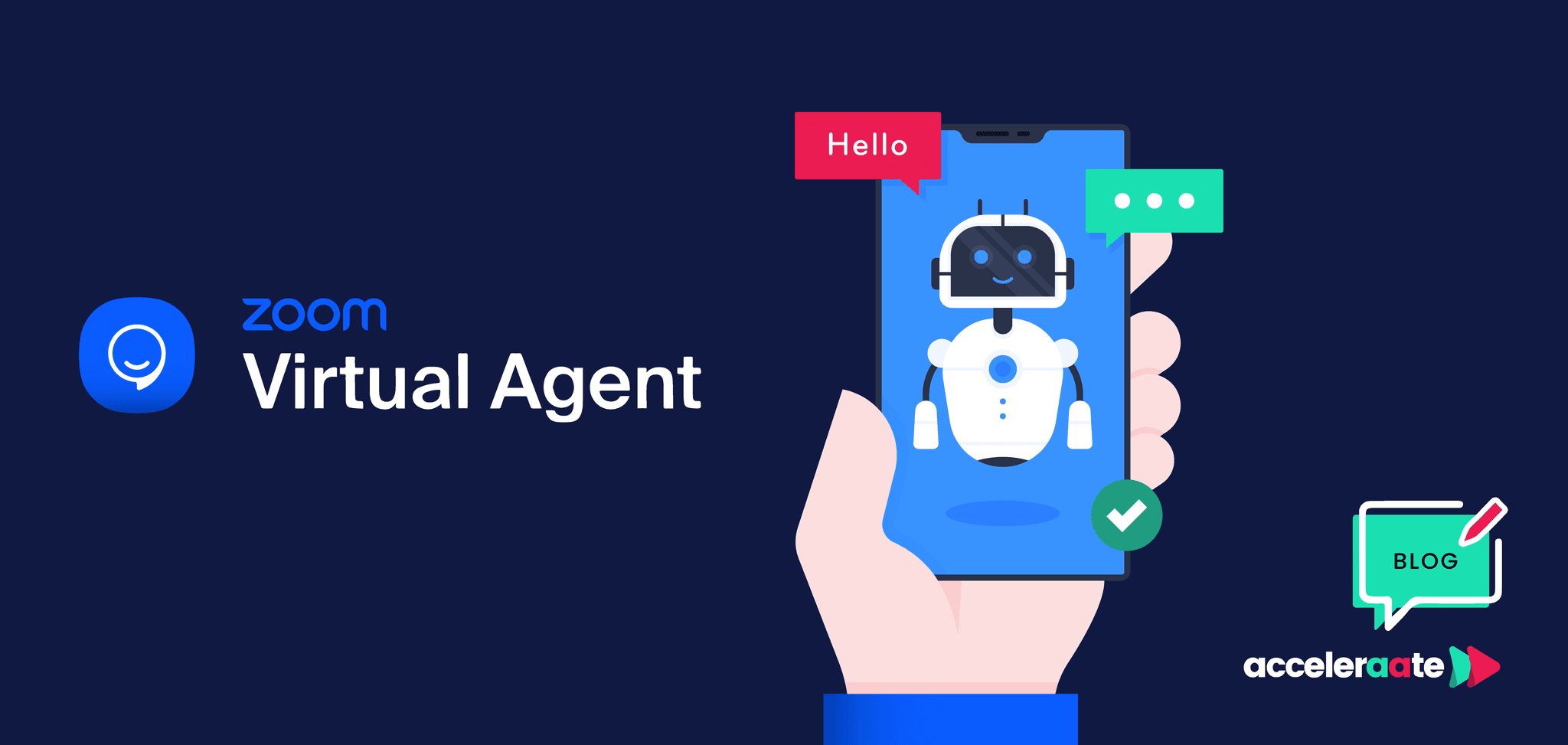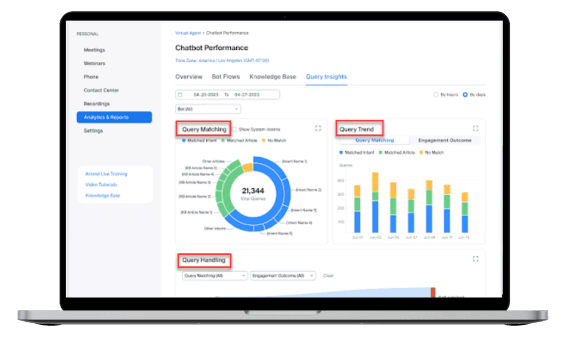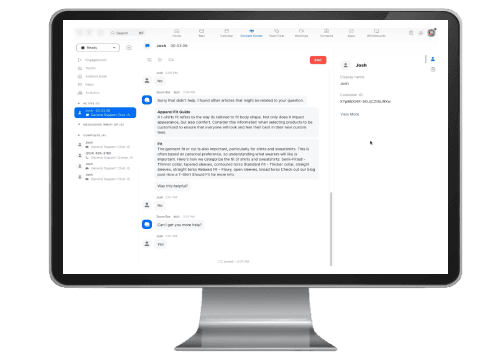
In Q1 2023 Zoom officially launched Zoom Virtual Agent (ZVA). As a relatively fast follow-on from the successful launch of the impressive Zoom Contact Center in 2022, we weren’t sure exactly what to expect from ZVA. Years of experience have taught us that so-called “AI” chat solutions are rarely particularly impressive, and often require a huge amount of implementation, bot training, and tuning effort to deliver against even the most basic use cases.
So, it would be fair to say that we initially approached ZVA with high hopes, but a healthy level of cynicism...
What is Zoom Virtual Agent?
ZVA is built on Zoom’s acquisition of Solvvy in 2022 and offers an intelligent conversational AI chatbot that works on multiple support channels to deliver fast, personalised customer experiences, reduce call volumes to agents, and drive significant operational efficiencies.
Powered by a combination of Zoom’s proprietary Machine Learning, Zoom Virtual Agent is a low-code, low-maintenance solution, giving businesses access to virtual tools without making a significant investment in software development and training.
Zoom has done a really nice job of integrating the solution into its wider platform, offering Zoom's simple and familiar UI, with a seamless integration into the Zoom Contact Center agent workspace.

How is Zoom Virtual Agent different?
When writing this review, we didn't want to solely provide a run-down of ZVA's features and functions. Instead, we decided to focus on what it actually delivers, and what makes it different (in some areas, unique) when compared to all the other AI chatbot solutions we've worked with previously.
So here's our run down of what ZVA offers and, more importantly, how it benefits your organisation.
Combines the power of intents, flows, and knowledge base into a single simple solution
We've worked with many different chatbot solutions over the years, and we've found that the technologies available tend to be good at very specific things. But all have their limitations and pitfalls, and this can often result in the solution being re-built in a different technology (for example, in a recent keynote at UCX Manchester 2023, Groupon's Director of Business Operations talked through their AI journey over the last few years, and admitted that they had rebuilt their chatbot service four times!)
There are generally two distinct types of chatbot solution (Flow/Decision Tree, and Knowledge Base) and for the sake of completeness we've detailed below these common types, and the pros and cons of each:
Flow/Decision Tree Bots
These type of chatbots support pre-defined intents and specific customer journeys that are specifically configured to guide the customer to the answer or outcome they require.
Pros
Create extremely refined customer experiences that can resolve very specific and common queries (e.g. "where is my order") due to their decision tree type implementation.
Can be easier to personalise based on customer history/context (e.g. can show the customer order details and specific tracking info) as the integration points are straightforward.
Very well suited to high volume/low value contact, that is predictable.
Cons
Anything outside of the pre-built intents and journeys is not supported. In these cases the bot will respond repeatably with “sorry I don’t understand” which can be a very frustrating experience!
Requires a lot of manual upfront and ongoing effort to implement and support changes as an organisation evolves.
Not well suited to FAQ type queries which change or are added to over time (for example, retail returns policy changes during peak trading periods).
Knowledge Base Bots
These type of chatbots ingest an external knowledge base or scrape a website where information already exists and is updated on a regular basis. Machine Learning is then applied to surface the most relevant response to a customer query.
Pros
Continues to "learn" and adapts answers to your organisation as it changes, due to continuous ingestion of knowledge base/website content.
Low effort to implement and maintain as the ongoing ingestion of knowledge can cover a lot of use cases and intents.
Well suited to use cases where the organisation covers a wide range of services (e.g. local authorities), and where answers already exist to customer queries, but they might be difficult to locate or customers prefer a more interactive method of engagement (e.g. how do I return my product?)
Cons
Experience can be fragmented or robotic as solutions can respond with large chunks of knowledge base text.
Harder to personalise the experience for individual customers as context is often missing and integration touchpoints are more complex.
Not suited to use cases where customer specific data is required.
Zoom Virtual Agent is different because it combines both types into a single intelligent solution whilst providing organisations with control and configurability of how the chatbot should respond.
This control includes the ability to set thresholds around confidence, as well as whether to guide the customer down a flow, or surface information from the knowledge base.
For example, if a customer says: "My product is faulty. I want a refund."
Zoom Virtual Agent AI searches Intents/Flows and Knowledge Base and finds the following related matches:
Refund Intent with a refund flow - 90% confidence
Knowledge Base "Can I get a refund?" - 70% confidence
Knowledge Base "How do I return?" - 50% confidence
In this scenario, the bot would guide the customer down the refund flow where it can gather further information such as an order number, and then provide a personalised experience through integration with the eCommerce platform.
If the refund flow didn't exist, the bot would instead show information from the knowledge base on "Can I get a refund?".
Native reporting that makes value easy to understand
A common complaint (or at least question) with AI chatbots is: "How do I know that it’s actually solving customer queries, and not just creating contact elsewhere?" Clients don’t want to need a degree in Data Science to understand this - they just want to know where it’s working, where it isn’t and the value the solution is driving.
Zoom has absolutely nailed this with ZVA's powerful onboard reporting, which enables organisations to understand which customers journeys have:
Self-serviced (i.e. customer was deflected/contained)
Been assisted by an agent by design (i.e. the journeys where you anticipate an agent being required)
Been assisted by an agent where you did not anticipate them being required
Dropped off
The reporting also includes estimated cost savings provided by each chatbot flow based on clients' own cost per interaction/engagement (e.g. WISMO = £3, Faulty Product = £5, etc.). Whilst other solutions out there may capture the data you can use to generate this insight, the fact that it is just there in the product really sets Zoom apart.
This is exactly how reporting and insights should be done!

Intelligent handoffs to more than just agents
For clients who are using Zoom Contact Center, the integration between Virtual Agent and Contact Center is completely seamless, providing a best-in-class experience for the customer, and the responding agent. If you have defined that a contact should be handed-off at a certain point in the journey the customer will be routed through to a best-fit agent (controlled by the extensive skill profiles in Zoom Contact Center). The handoff process enables the agent to preview the conversation to date, and also preview customer details prior to accepting the interaction.
Once the agent has accepted the interaction, all of this information is instantly populated in the Zoom agent workspace, allowing the agent to pick up where the bot left off and manage the contact through to a swift resolution. This native preview and handoff functionality is currently only available when deployed in tandem with Zoom Contact Center.

But uniquely, Zoom Virtual Agent can also hand-off to other channels, and not just to your human agents. Hand-offs can be completed into your Ticketing System (e.g. Zendesk), to an Email inbox, to a Phone number, or to a web link. This provides enormous flexibility for ZVA users, enabling clients to test, measure, and iterate the optimal journeys for each type of contact, customer, and enquiry.
Open platform with out-of-the-box integrations
Zoom Virtual Agent does not require Zoom Contact Center and can be deployed as a standalone AI chatbot alongside other contact centre solutions which is an extremely refreshing approach, and testament to Zoom's open nature (it works and plays nicely with lots of competitors e.g. Microsoft Teams, Five9, Genesys, NICE).
There are clearly huge benefits to deploying both ZVA and ZCC (not least the seamless agent hand-off and elevation to video options), but a lot of organisations might not be in a position to re-platform their contact centre, and need to squeeze every last penny out of the investment they've already made. The great news is that Zoom Virtual Agent is perfect for this, and from our perspective as a technology-agnostic partner, it provides us with the opportunity to recommend and deploy the right technical solution for the client’s need.
ZVA also offers native integrations for Zendesk, Genesys, Sunshine, Kustomer, ServiceNow, Salesforce, Gorgias, Intercom, ManageEngine, Confluence, with more on the way. These native integrations offer simple setup for knowledge base ingestion and customer hand-off, further reducing setup time.
In Summary
Zoom Virtual Agent helps to solve several of the legacy problems associated with delivering high-performing AI self-service in a contact centre/customer service environment. The fact that the product supports intent detection, custom bot flow journeys, API integration, and automated knowledge base parsing means that all bases are covered when it comes to providing the right answers, at the right time. Deployment and tuning are also relatively straightforward, especially given the quality of the onboard reporting, meaning that an experienced Zoom Solution Partner (like Acceleraate) can have Zoom Virtual Agent deployed and delivering meaningful results within 60 days.
In a world where instancy, impatience, and expectations are the order of the day, Zoom Virtual Agent provides clients with a realistic chance of delivering customer self-service that performs; reducing wait times, delivering faster resolutions, increasing CSAT, and scaling up customer personalisation.
About Acceleraate
Acceleraate is a Zoom Solution Partner, Zoom Authorised Reseller, and the first UK Zoom partner to achieve the Zoom Customer Experience (ZCX) Competency certification. We are CX and customer service optimisation experts and specialise in solving problems by uniting cloud technology with smart and straightforward thinking. We focus on helping businesses reduce effort, improve loyalty, and maximise cost efficiency.
With over 15 years of hands-on experience designing, implementing, and managing cloud contact centres and AI solutions for some of the UK's best-known businesses and brands, Acceleraate delivers CX strategy, implementation, system integration, optimisation, and managed services for business.
Looking to drive up customer self-service and efficiency?
About the author

Part of Founded Group Limited








